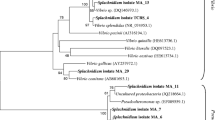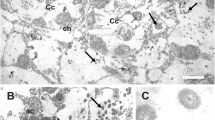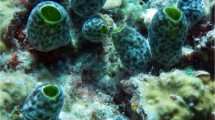Abstract
Pseudopterogorgia elisabethae is a common inhabitant of Caribbean reefs and is a well-known source of diterpenes with diverse biological activities. Notably, this octocoral is the sole source of the pseudopterosin family of anti-inflammatory diterpenes and is harvested to supply commercial demand for these metabolites. We have characterized the composition of the bacterial community associated with P. elisabethae collected from Providencia Island, Colombia, using both culture-dependent and culture-independent approaches. Culture-independent analysis revealed that the bacterial communities were composed of eight phyla, of which Proteobacteria was the most abundant. At the class level, bacterial communities were dominated by Gammaproteobacteria (82–87 %). Additionally, operational taxonomic units related to Pseudomonas and Endozoicomonas species were the most abundant phylotypes consistently associated with P. elisabethae colonies. Culture-dependent analysis resulted in the identification of 40 distinct bacteria classified as Bacilli (15), Actinobacteria (12), Gammaproteobacteria (9), Alphaproteobacteria (3), and Betaproteobacteria (1). Only one of the 40 cultured bacteria was closely related to a dominant phylotype detected in the culture-independent study, suggesting that conventional culturing techniques failed to culture the majority of octocoral-associated bacterial diversity. To the best of our knowledge, this is the first characterization of the bacterial diversity associated with P. elisabethae.


Similar content being viewed by others
References
Bourne DG, Munn CB (2005) Diversity of bacteria associated with the coral Pocillopora damicornis from the Great Barrier Reef. Environ Microbiol 7:1162–1174
Kvennefors EC, Sampayo E, Ridgway T, Barnes AC, Hoegh-Guldberg O (2010) Bacterial communities of two ubiquitous Great Barrier Reef corals reveals both site- and species-specificity of common bacterial associates. PLoS One 5:e10401
Littman RA, Willis BL, Pfeffer C, Bourne DG (2009) Diversities of coral-associated bacteria differ with location, but not species, for three acroporid corals on the Great Barrier Reef. FEMS Microbiol Ecol 68:152–163
Mouchka ME, Hewson I, Harvell CD (2010) Coral-associated bacterial assemblages: current knowledge and the potential for climate-driven impacts. Integr Comp Biol 50:662–674
Neulinger SC, Järnegren J, Ludvigsen M, Lochte K, Dull WC (2007) Phenotype-specific bacterial communities in the cold-water coral Lophelia pertusa (Scleractinia) and their implications for the coral's nutrition, health, and distribution. Appl Environ Microbiol 74:7272–7285
Reshef L, Koren O, Loya Y, Zilber-Rosenberg I, Rosenberg E (2006) The coral probiotic hypothesis. Environ Microbiol 8:2068–2073
Ritchie KB (2006) Regulation of microbial populations by coral surface mucus and mucus-associated bacteria. Mar Ecol Prog Ser 322:1–14
Sacristán-Soriano O, Banaigs B, Casamayor EO, Becerro MA (2011) Exploring the links between natural products and bacterial assemblages in the sponge Aplysina aerophoba. Appl Environ Microbiol 77:862–870
Brück TB, Brück WM, Santiago-Vazquez LZ, McCarthy PJ, Kerr RG (2007) Diversity of the bacterial communities associated with the azooxanthellate deep water octocorals Leptogorgia minimata, Iciligorgia schrammi, and Swiftia exertia. Mar Biotechnol 9:561–576
Gray MA, Stone RP, McLaughlin MR, Kellogg CA (2011) Microbial consortia of gorgonian corals from the Aleutian Islands. FEMS Microbiol Ecol 76:109–120
Santiago-Vazquez LZ, Brück TB, Brück WM, Duque-Alarcon AP, McCarthy PJ, Kerr RG (2007) The Diversity of the bacterial communities associated with the azooxanthellate hexacoral Cirrhipathes lutkeni. ISME J 1:654–659
Sunagawa S, Woodley CM, Medina M (2010) Threatened corals provide underexplored microbial habitats. PLoS One 5:e9554
Mayer AMS, Glaser KB, Cuevas C, Jacobs RS, Kem W, Little RD, McIntosh JM, Newman DJ, Potts BC, Shuster DE (2010) The odyssey of marine pharmaceuticals: a current pipeline perspective. Trends Pharmacol Sci 31:255–265
Berrue F, Kerr RG (2009) Diterpenes from gorgonian corals. Nat Prod Rep 26:681–710
Leal MC, Puga J, Serôdio J, Gomes NCM, Calado R (2012) Trends in the discovery of new marine natural products from invertebrates over the last two decades—where and what are we bioprospecting? PLoS One 7:e30580
Chen YH, Kuo J, Su JH, Hwang TL, Chen YH, Lee CH, Weng CF, Sung PJ (2012) Pseudoalteromone B: a novel 15C compound from a marine bacterium Pseudoalteromonas sp. CGH2XX. Mar Drugs 10:1566–1571
Boya CA, Herrera L, Guzman HM, Gutierrez M (2012) Antiplasmodial activity of bacilosarcin A isolated from the octocoral-associated bacterium Bacillus sp. collected in Panama. J Pharm Bioallied Sci 4:66–69
Zhang XY, He F, Wang GH, Bao J, Xu XY, Qi SH (2013) Diversity and antibacterial activity of culturable actinobacteria isolated from five species of the South China Sea gorgonian corals. World J Microbiol Biotechnol 29:1107–1116
Gao CH, Tian XP, Qi SH, Luo XM, Wang P, Zhang S (2010) Antibacterial and antilarval compounds from marine gorgonian-associated bacterium Bacillus amyloliquefaciens SCSIO 00856. J Antibiot 63:191–193
Thomas TR, Kavlekar DP, LokaBharathi PA (2010) Marine drugs from sponge-microbe association—a review. Mar Drugs 8:1417–1468
Roué M, Quévrain E, Domart-Coulon I, Bourguet-Kondracki ML (2012) Assessing calcareous sponges and their associated bacteria for the discovery of new bioactive natural products. Nat Prod Rep 29:739–751
Blunt JW, Copp BR, Hu WP, Munro MHG, Northcote PT, Prinsep MR (2008) Marine natural products. Nat Prod Rep 25:35–94
Debnath M, Paul AK, Bisen PS (2007) Natural bioactive compounds and biotechnological potential of marine bacteria. Curr Pharm Biotechnol 8:253–260
Fenical W, Jensen PR (2006) Developing a new resource for drug discovery: marine actinomycete bacteria. Nat Chem Biol 2:666–673
Mydlarz LD, Jacobs RS, Boehnlein JM, Kerr RG (2003) Pseudopterosin biosynthesis in Symbiodinium sp, the dinoflagellate symbiont of Pseudopterogorgia elisabethae. Chem Biol 10:1051–1056
Rowan R, Powers DA (1992) Ribosomal RNA sequences and the diversity of symbiotic dinoflagellates (zooxanthellae). Proc Natl Acad Sci U S A 89:3639–3643
Callaway TR, Dowd SE, Wolcott RD, SunY MRJL, Edrington TS, Byrd JA, Anderson RC, Krueger N, Nisbet DJ (2009) Evaluation of the bacterial diversity in fecal contents of laying hens fed various molting diets by using bacterial tag-encoded FLX amplicon pyrosequencing. Poult Sci 88:298–302
Schloss PD, Westcott SL, Ryabin T, Hall JR, Hartmann M, Hollister EB, Lesniewski RA, Oakley BB, Parks DH, Robinson CJ, Sahl JW, Stres B, Thallinger GG, Van Horn DJ, Weber CF (2009) Introducing mothur: open-source, platform-independent, community-supported software for describing and comparing microbial communities. Appl Environ Microbiol 75:7537–7541
Schloss PD, Gevers D, Westcott SL (2011) Reducing the effects of PCR amplification and sequencing artifacts on 16S rRNA-based studies. PLoS One 6:e2731
Mothur wiki (2013) Schloss SOP. http://www.mothur.org/wiki/Schloss_SOP. Accessed January 2013
Wang Q, Garrity GM, Tiedje JM, Cole JR (2007) Naïve Bayesian classifier for rapid assignment of rRNA sequences into the new bacterial taxonomy. Appl Environ Microbiol 73:5261–5267
Altschul SF, Gish W, Miller W, Myers EW, Lipman DJ (1990) Basic local alignment search tool. J Mol Biol 215:403–410
Cole JR, Wang Q, Cardenas E, Fish J, Chai B, Farris RJ, Kulam-Syed-Mohideen AS, McGarrell DM, Marsh T, Garrity GM, Tiedje JM (2009) The Ribosomal Database Project: improved alignments and new tools for rRNA analysis. Nucleic Acids Res 37:D141–D145
Edwards U, Rogall T, Blöcker H, Emde M, Böttger EC (1989) Isolation and direct complete nucleotide determination of entire genes. Characterization of a gene coding for 16S ribosomal RNA. Nucleic Acids Res 17:7843–7853
Gontang EA, Fenical W, Jensen PR (2007) Phylogenetic diversity of gram-positive bacteria cultured from marine sediments. Appl Environ Microbiol 73:3272–3282
Larkin MA, Blackshields G, Brown NP, Chenna R, McGettigan PA, McWilliam H (2007) Clustal W and Clustal X version 2.0. Bioinformatics 23:2947–2948
Euzéby JP (1997) List of bacterial names with standing in nomenclature: a folder available on the Internet. Int J Syst Bacteriol 47:590–592
Saitou N, Nei M (1987) The neighbor-joining method: a new method for reconstructing phylogenetic trees. Mol Biol Evol 4:406–425
Kimura M (1980) A simple method for estimating evolutionary rate of base substitutions through comparative studies of nucleotide sequences. J Mol Evol 16:111–120
Tamura K, Dudley J, Nei M, Kumar S (2007) MEGA4: Molecular Evolutionary Genetics Analysis (MEGA) software version 4.0. Mol Biol Evol 24:1596–1599
Felsenstein J (1985) Confidence limits on phylogenies: an approach using the bootstrap. Evolution 39:783–791
Bourne DG, Dennis PG, Uthicke S, Soo RM, Tyson GW, Webster N (2013) Coral reef invertebrate microbiomes correlate with the presence of photosymbionts. ISME J 7:1459
Barott KL, Rodriguez-Brito B, Janouškovec J, Marhaver KL, Smith JE, Keeling P, Rohwer FL (2011) Microbial diversity associated with four functional groups of benthic reef algae and the reef-building coral Montastraea annularis. Environ Microbiol 13:1–13
Jackson SA, Kennedy J, Morrissey JP, O'Gara F, Dobson AD (2012) Pyrosequencing reveals diverse and distinct sponge-specific microbial communities in sponges from a single geographical location in Irish waters. Microb Ecol 64:105–116
Webster N, Bourne D (2007) Bacterial community structure associated with the Antarctic soft coral, Alcyonium antarcticum. FEMS Microbiol Ecol 59:81–94
Bourne DG, Iida Y, Uthicke S, Smith-Keune C (2008) Changes in coral-associated microbial communities during a bleaching event. ISME J 2:350–363
Penn K, Wu D, Eisen JA, Ward N (2006) Characterization of bacterial communities associated with deep-sea coral on Gulf of Alaska seamounts. Appl Environ Microbiol 72:1680–1683
Raina JB, Tapiolas D, Willis BL, Bourne DG (2009) Coral-associated bacteria and their role in the biogeochemical cycling of sulfur. Appl Environ Microbiol 75:3492–3501
Santos SR, Gutiérrez-Rodriguez C, Lasker HR, Coffroth MA (2003) Symbiodinium sp. association in the gorgonian Pseudopterogorgia elisabethae in the Bahamas: high levels of genetic variability and population structure in symbiotic dinoflagellates. Mar Biol 143:111–120
Berdy J (2005) Bioactive microbial metabolites. J Antibiot 58:1–26
Kvennefors EC, Sampayo E, Kerr C, Vieira G, Roff G, Barnes AC (2011) Regulation of bacterial communities through antimicrobial activity by the coral holobiont. Microb Ecol 63:605–618
Friedline CJ, Franklin RB, McCallister SL, Rivera MC (2012) Microbial community diversity of the eastern Atlantic Ocean reveals geographic differences. Biogeosci Discuss 9:109–150
Stackebrandt E, Ebers J (2006) Taxonomic parameters revisited: tarnished gold standards. Microbiol Today 4:152–155
Jensen PR (2010) Linking species concepts to natural product discovery in the post-genomic era. J Ind Microbiol Biotechnol 37:219–224
Klaus JS, Janse I, Heikoop JM, Sanford RA, Fouke BW (2007) Coral microbial communities, zooxanthellae and mucus along gradients of seawater depth and coastal pollution. Environ Microbiol 9:1291–1305
Correa H, Aristizabal F, Duque C, Kerr R (2011) Cytotoxic and antimicrobial activity of pseudopterosins and seco-pseudopterosins isolated from the octocoral Pseudopterogorgia elisabethae of San Andrés and Providencia Islands (SW Caribbean). Mar Drugs 9:334–344
Ivanova EP, Vysotskii MV, Svetashev VI, Nedashkovskaya OI, Gorshkova NM, Mikhailov VV, Yumoto N, Shigeri Y, Taguchi T, Yoshikawa S (1999) Characterization of Bacillus strains of marine origin. Int Microbiol 2:267–271
Rypien KL, Ward JR, Azam F (2010) Antagonistic interactions among coral-associated bacteria. Environ Microbiol 12:28–39
Pace NR (1997) A molecular view of microbial diversity and the biosphere. Science 276:734–740
Ward DM, Weller R, Bateson MM (1990) 16S rRNA sequences reveal numerous uncultured microorganisms in a natural community. Nature 345:63–65
Vartoukian SR, Palmer RM, Wade WG (2010) Strategies for culture of ‘unculturable’ bacteria. FEMS Microbiol Lett 309:1–7
Connon SA, Giovannonis SJ (2002) High-throughput methods for culturing microorganisms in very-low-nutrient media yield diverse new marine isolates. Appl Environ Microbiol 68:3878–3885
Acknowledgments
This work was partially financed by grants from the Colciencias and Universidad Nacional de Colombia. The Ministerio de Ambiente, Vivienda y Desarrollo Territorial granted collection and research permits (permission no. 4 of 10/02/2010). HC, BH, and RK gratefully acknowledge the financial support from the Natural Sciences and Engineering Council of Canada, the Canada Research Chair Program, the University of Prince Edward Island, the Atlantic Innovation Fund, and the Jeanne and Jean-Louis Lévesque Foundation.
Author information
Authors and Affiliations
Corresponding author
Rights and permissions
About this article
Cite this article
Correa, H., Haltli, B., Duque, C. et al. Bacterial Communities of the Gorgonian Octocoral Pseudopterogorgia elisabethae . Microb Ecol 66, 972–985 (2013). https://doi.org/10.1007/s00248-013-0267-3
Received:
Accepted:
Published:
Issue Date:
DOI: https://doi.org/10.1007/s00248-013-0267-3




